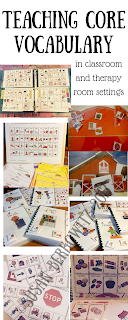Over the past 2 months I’ve been talking a lot about beginning with augmentative communication; including what it is and who needs it. The next question I most often get from parents, teachers and SLPs is about what kinds of materials are needed for intervention (and “where the heck do I find them”)?
We all know that genuine communication interactions in context are the best for teaching any communication skill. Too often in AAC implementation we “test” more than teach. We ask students to identify symbols at random, or find target words outside of any social engagement or genuine interaction.
Since many of our students require additional specific, structured practice beyond the opportunities throughout their school day, I encourage role playing and simulations. There are a lot of ways to do this; such as including using props, dress-up, role playing, and using books and apps.
We also know that our students need to have a robust communication system; either no/light tech or high tech systems. Again, there are dedicated devices that use core words as well as categories of fringe words, AAC apps that are similarly robust with sufficient vocabulary to meet all of their communication needs, and dynamic communication books that have robust vocabulary to meet a variety of communication functions.
Systems that are either totally core word based (with available fringe words) or are function/pragmatically based but include the same high frequency words, are robust enough to meet many needs.
Much research has been done on language development in general, and on the acquisition and use of early words; especially those words we know of as “core words.” But, somehow, we often seem to get stuck with those first 15, 25, or 32 core words. Sometimes even SLPs forget about 2-word combinations when teaching AAC users. But isn’t that the natural next place to go?
I love it when I hear SLPs or teachers exclaim, “Look! He’s putting two words together.”
Two word combinations are necessary to convey meaning when one of those words is a noun. “Apple.” Well, what about an apple? Do you want an apple? Did your apple fall on the floor? Did someone take your apple? Are you tired of apples?
But think of the magic of communication when combining two core words. All of the multiple meanings of both words create powerful combinations. “Want apple.” “Not apple.” “Give apple.” “Bad apple.” Good apple.” “More apple.” I’ve made meaning intelligible, and I’ve covered - how many functions?
I have made a great many resources available in my TPT store for AAC implementation.
One that I particularly enjoy is my AAC Starter Kit, because it provides a robust picture communication book that employs basic core and adds a variety of fringe topics and concepts.
When the book is assembled, it shows the easy to access to core words, as well as the variety of fringe words available.
The kit also includes my 10 Weeks to 40 Core Words. The activities for teaching use of core words in this resource are similar to my other Activities and Games for a Year of Core and Teach Me Core Words resources.
I have attempted to provide both suggestions for using core words in every day routines and activities, as well as activities to simulate other real-life activities that you may not have access to within your intervention setting or classroom.
There are 4 target core words per week, planned out over 10 weeks. You may need a different pace for your students, and that is certainly fine. Move at a pace that works for the students you are working with; making sure to always presume competence, provide maximum opportunities for genuine communicating, and use the least intrusive cues and prompts possible. Consistent partner use of Aided Language Stimulation is crucial.
For each of those 4 word groups, there is a different lesson plan/activity suggestion/contextual idea(s) for each day of the week. The words are provided on large cards (approximately 4.5 X 3) for use in the classroom, as well as on a complete 40-location communication board. Each week you will get a small book to read with the student(s) on Day 2 that uses those words. When possible, act out the statements in the book in real time, giving a context with real objects and people.
The books can be interactive; having students place the appropriate symbol on each page of each book.
Simulation activities for each week include activities such as an Animal Escape game, making a volcano, blowing bubbles, playing a familiar game, building a pizza, doing a group puzzle, and more. 3X5 sized cards for use on a classroom board come in white background as well as red & yellow for students with cortical vision issues.
Also in the starter kit is my Teach Me 6 Core Words resource and Teach Me More Core Words resource; each of which has a variety of simulation activities. Order a pizza, order animals back to the barn, get dressed for the weather, go to the store are some of the activities.
And my 3 Games for AAC practice are also in this set. The first game involves students picking a card from a pile and finding the words in their AAC system. The second game uses dice to provide a single core word and asks students to create a phrase using that word. The third game is a bit like Scrabble, but uses core words tiles rather than single letter tiles, and has students build phrases and sentences using the words they’ve picked.
There are more than 500 pages in this resource, with enough activities to keep your AAC users learning to use language throughout the year - and beyond!
However you choose to do it, keep your AAC users “talking!”













Playgroup is the most energizing yet imperative period of your kid. The kids out of the blue leave the solace of their folks and begin to communicate with the earth. Play School in HSR Layout
ReplyDelete